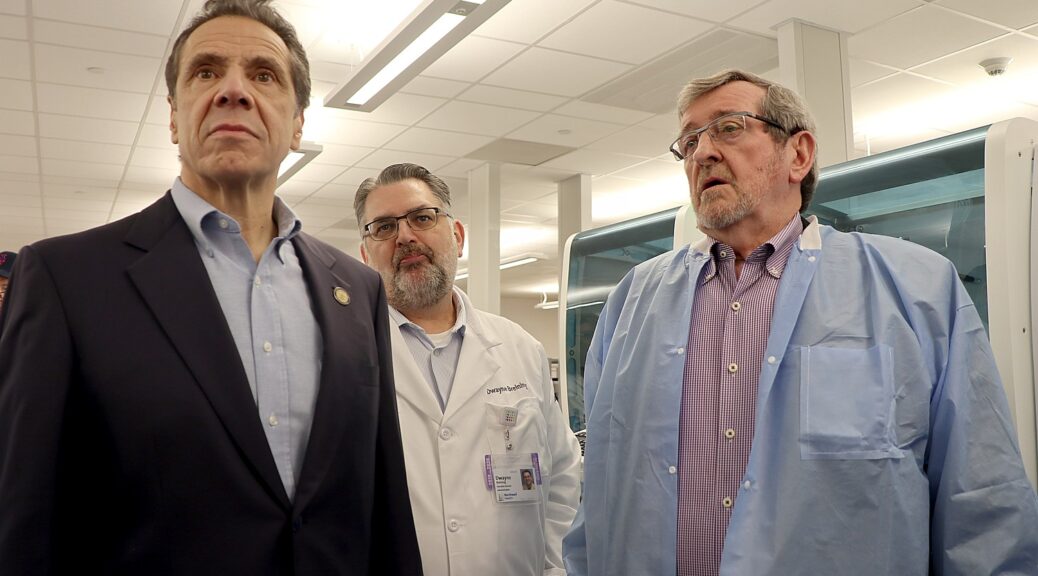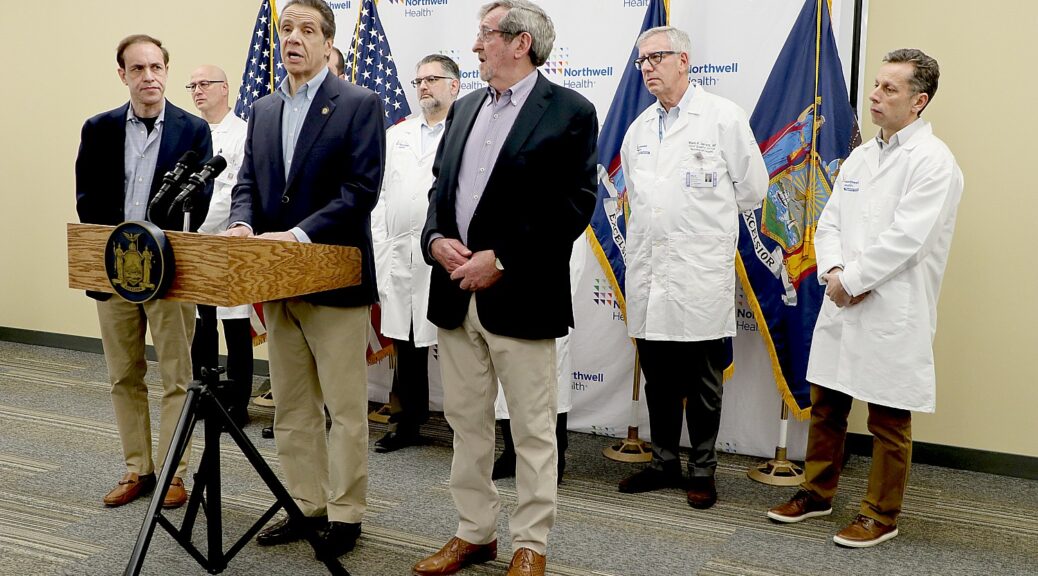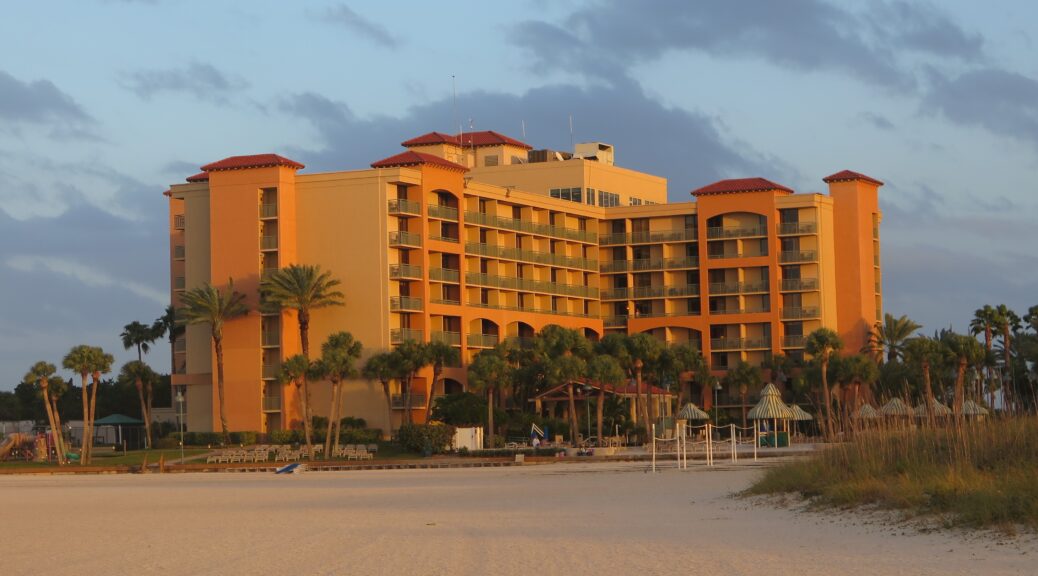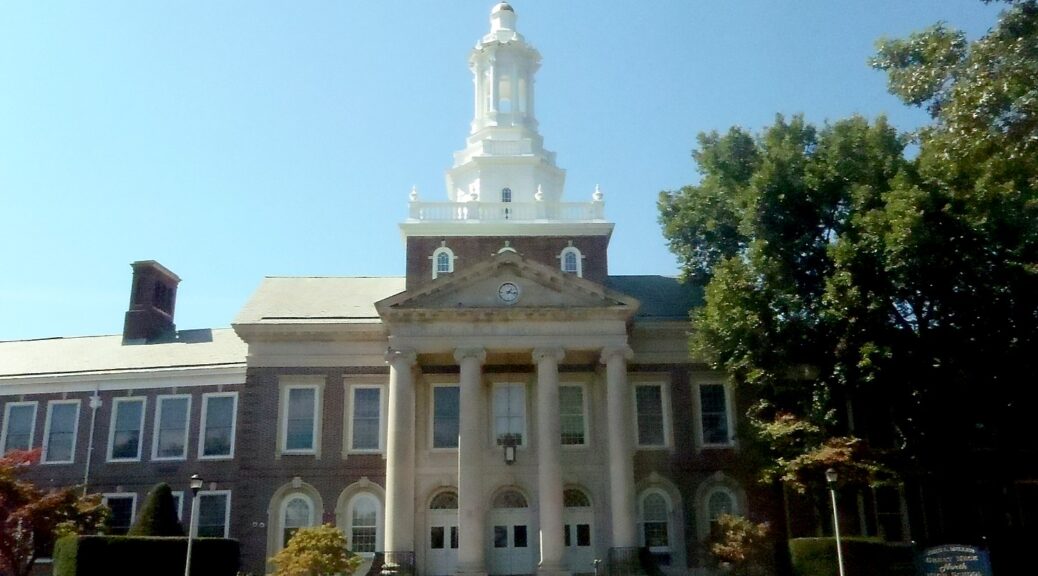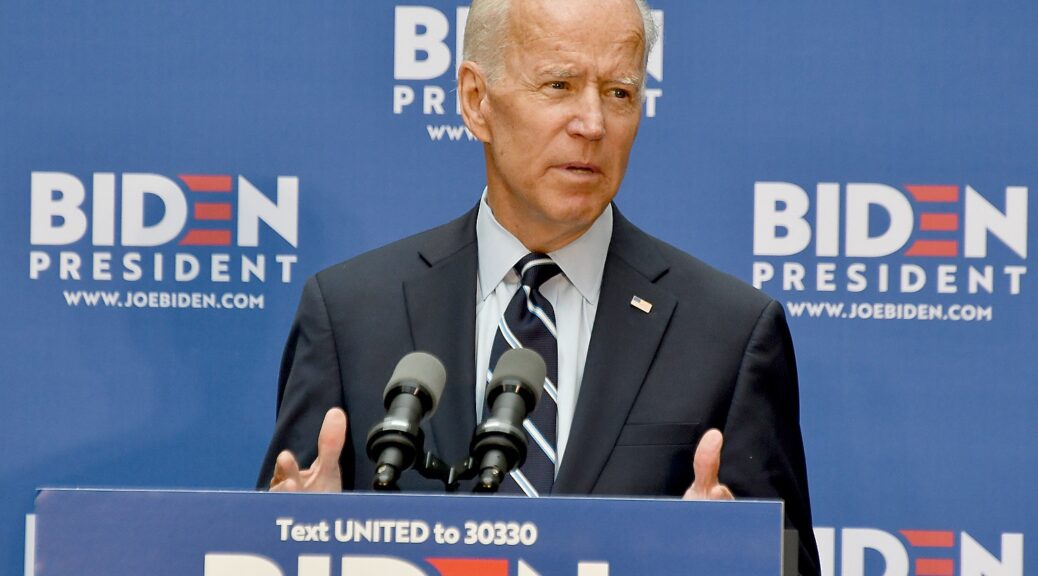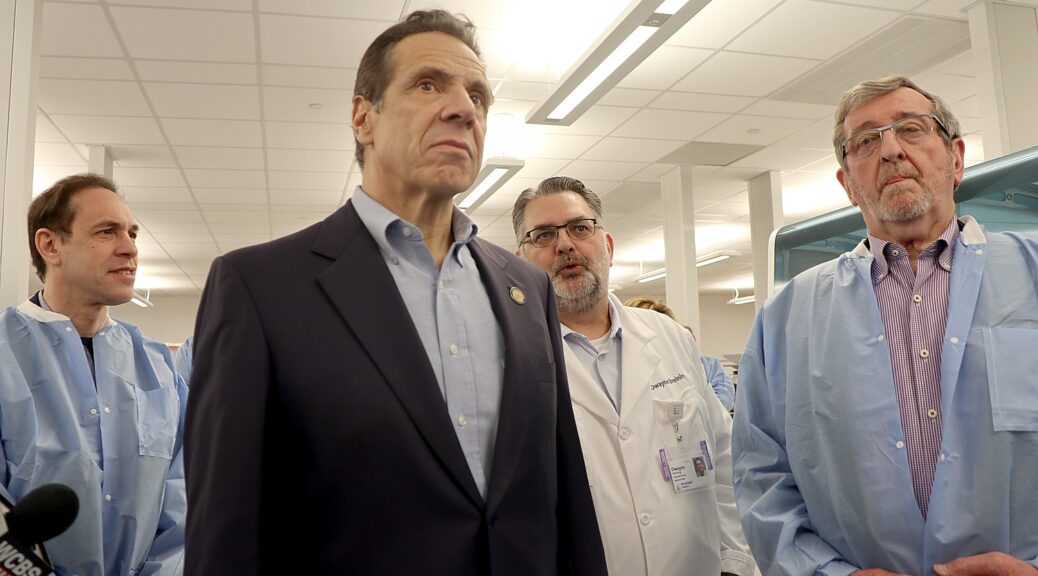
Cuomo: “My last point is practice humanity. We don’t talk about practicing humanity, but now if ever there is a time to practice humanity the time is now. The time is now to show some kindness, to show some compassion to people, show some gentility – even as a New Yorker.”
Trump has played a pathetic game of catch-up to the actual task of getting Americans through the coronavirus pandemic as best as possible, with as few deaths and as little destruction to the economy and society as possible. While he has proved a mendacious inept clog, true leadership has been demonstrated by Governors, especially New York Governor Andrew Cuomo. His press availability today, in which he gave updates on his nonstop effort to increase hospital capacity and obtain necessary protective equipment and medical supplies in anticipation of a surge of patients, was heartening to New Yorkers. It was a speech that hearkened to Franklin Delano Roosevelt, who was Governor of New York before he was President, leading the nation through the Great Depression and later through World War II. This is a rush transcript of the Governor’s remarks:
Good morning. Happy Saturday. Welcome to the weekend. I want to give you an update and briefing on where we are today and then we’re going to go out and do some real work, get out of this building before we get cabin fever. You know the people who are here today. From my far right, Simonida Subotic who is in charge of managing supplies which is a major function for us, Robert Mujica, Director of Division of the Budget, Melissa DeRosa, Secretary to the Governor, the great James Malatras who has been a tremendous help here.
Go through the facts, the numbers are still increasing. We have been seeing that. That’s the line that we’re tracking. This is all about the increase in the number of cases and managing the increase in the number of cases to the capacity of our health care system. What are we doing? We’re reducing the spread and the rate of the spread to match the increase in the number of cases and increasing hospital capacity at the same time – just how do our hospitals manage the rate of the spread.
We’re trying to reduce the spread to over a period of months. Over a period of months our healthcare system can deal with the numbers. We have moved to zero non-essential workers. You can’t go below zero so we’re doing everything we can there and we put out new rules on personal conduct and what people should be doing and how they should be behaving and where they should be.
Matilda’s Law which is for the vulnerable population, senior citizens, people with compromised immune systems, underlying illnesses – that was very specific. As I mentioned we named it for my mother Matilda because I went through this with my own siblings. How do we help mom? Where do we bring mom? There was a difference of opinion. The best health professionals put together guidelines that not only help senior citizens but also their families who are trying to deal with this. I know it was helpful to my family and the question among siblings these laws and guidelines answered. I don’t want to mention which sibling but it turns out that he was wrong.
The personal conduct rules and regulations are also very helpful. I want to thank Dr. Fauci who is really an extraordinary American and has given me great guidance and help and assistance in putting together these policies so I’d like to thank him and we’re doing those.
We’re working on every level. Every pistol is firing. Everything that can be done is being done. New Yorkers are lucky. We have a very experienced team that’s doing this. This is not their first rodeo. They’ve been through a number of emergencies on a number of levels.
Increasing hospital capacity – we want to get the capacity of 50,000 thousand up to a minimum of 75,000. We told the hospitals we’re going to be ending elective surgeries. We are now working with hospitals to reconfigure the space in the hospital to get more beds and to find more staff to manage those beds. We’re working on building new beds. We’re going to go out and review a number of sites today. I’d like to give the final list to the federal government and the Army Corps of Engineers today but we’re looking at Javits, SUNY Stony Brook, SUNY Westbury, the Westchester Convention Center, and I’m going to go out and take a look at those sites today or the ones I can get to. That would give us a regional distribution and a real capacity if we can get them up quickly enough and then increasing supplies which is one of the most critical activities.
We are literally scouting the globe looking for medical supplies. We’ve identified 2 million N-95 masks which are the high protection masks. We have apparel companies that are converting to mask manufacturing companies in the State of New York in all sorts of creative configurations and I want to thank them. I put out a plea yesterday to ask them for help and we’ve been on the phone with all sorts of companies who are really doing great work. We’re also exploring the State of New York manufacturing masks ourselves.
We’re going to send 1 million N95 masks to New York City today. That’s been a priority for New York City and 1 million masks won’t get us through the crisis but it’ll make a significant contribution to New York City’s mask issue and I want to thank Mayor de Blasio for working in partnership. We’re sending 500,000 N95 masks to Long Island. We’ve been working with County Executive Laura Curran and County Executive Steve Bellone and I want to thank them.
We’re gathering ventilators. Ventilators are the most important piece of equipment and the piece of equipment that is most scarce. We’re gathering them from all different health facilities across the state and then we’re going to use those in the most critical areas. We also identified 6,000 new ventilators that we can actually purchase so that’s a big deal.
From the federal government’s point of view I’ve spoken to the President a number of times. I spoke to the Vice President a number of times. They’ve issued a federal disaster declaration which is a technical act by the federal government but what it basically does is it allows the federal emergency management agency called FEMA to step in and assist financially. By that declaration FEMA would pay 75 percent of the cost of a disaster. New York State would pay 25 percent of the cost. The federal government can waive the 25 percent of the cost. I’m asking them to waive that 25 percent in this situation. I’ve worked on many disasters, FEMA has waived the 25 percent. If there’s any situation where FEMA should waive the 25 percent, this is the situation.
We’re also working with the federal government. We’re requesting 4 field hospitals at 250 capacity each. That would give us 1000 field hospital beds. We’re going to be looking at Javits as a location for those field hospitals. We’re also requesting 4 Army Corps of Engineers temporary hospitals. Those are the sites I mentioned earlier that I’m going to take a look at. The SUNY Stonybrook, Westbury, Westchester Convention Center and also Javits. Javits is so big that it can take the 4 field hospitals and an Army Corps of Engineers temporary hospital. We’re also requesting assistance with medical supplies which has been a very big topic of conversation all across the country.
We’re also asking our federal congressional delegation to fix a law that was passed on the coronavirus federal aid because of a technical issue the way the bill was written, New York State does not qualify for aid. That’s over $6 billion, that is a lot of money and we need the federal delegation to fix that bill otherwise New York State gets nothing. New York State has more coronavirus cases than any state in the United States of America. That we should not be included in the bill, obviously makes no sense.
We’re also going to conduct immediately trials for the new drug therapy which we have been discussing. I spoke to Dr. Zucker about it. There is a theory that the drug treatment could be helpful. We have people who are in serious condition and Dr. Zucker feels comfortable, as well as a number of other health professionals, that in a situation where a person is in dire circumstance, try what you can. The FDA is going to accelerate to New York 10,000 doses. As soon as we get those doses we will work with doctors, nurses and families on using those drugs and seeing where we get.
I spoke to the President, he spoke to this drug therapy in his press conference yesterday and I spoke to him afterward. I said that New York would be interested and we have the most number of cases and health professionals have all recommended to me that we try it, so we’ll try it. We’re also working on a number of other drug therapies, an anti-body therapy, a possible vaccine. We have a company here in New York called Regeneron that’s really showing some promising results. I exempted them from the no work order, because they couldn’t possibly have a really significant achievement for us. The new numbers, the more tests you take, the more positives you find, and I give this caution because I think people misinterpret the number of new cases. They take that number of new cases as if it is reflective of the number of new cases, the spread. It is not. The number of new cases is only reflective of the number of cases you are taking, right. Where our goal is to find the positive cases, because if we find a positive case we can isolate that person, and that stops the spread. So we’re actually looking for positives. The more tests you take, the more positives you will find.
We are taking more tests in New York than anyplace else. We’re taking more tests per capita than China or South Korea. We’re also taking more tests than any state in the United States of America. That is actually a great accomplishment. Because if you remember back, two weeks, which seems like a lifetime now, the whole question was coming up to scale on tests. How do we get the number of tests up and how do we get it up quickly? I spoke to the president and the vice president and said decentralize the testing, let the states do it. I have 200 labs. I can mobilize quickly. Let us do the tests. They agreed. We’re doing more tests than any state, so for example, we’ve done 45,000 tests. California has done 23,000, Washington has done 23,000, so you see how many more tests we are doing. And again, I credit the team that’s working here, because this is exactly what the mandate was. Perform as many tests as quickly as you can, and that’s the drive-thrus we’ve put in place, the hospital management, et cetera. So our numbers should be higher. And they are.
Total number of positive cases now is up to 10,000, number of new cases has increased by 3,000, let’s go back in case you can’t read as fast as I can read. 6,000 New York City, 1,300 Westchester, 1,200 in Nassau. You see the Westchester number is slowing. We did a New Rochelle containment area. The numbers would suggest that that has been helpful. So I feel good about that. You see Nassau increasing, you see Suffolk increasing. So that’s just the wide spread increase that we have been anticipating. But our hotspot of Westchester is now slowing, and that’s very good news. New York City, it is the most dense environment. This virus spreads in density, right. And that’s what you’re seeing in New York City, obviously, has many more people than any other specific location in the state. Number of counties are increasing. You see the blue. I said to you early on that blue is going to take over the whole state, just the way every state in the United States has now been covered. Most impacted states, you look at the cases in New York is 10,000, Washington, California, 1,000 each. Does that mean that we have ten times the number of cases as California or Washington? Or does that mean we’re doing more tests than California or Washington? The truth is somewhere in the middle, and nobody can tell you. Total number of people tested, we’re up to 45,000. Number of new tests. This is a rate that we watch. What is the rate of hospitalization? Again, because this is all about hospital capacity, right, 1,500 out of 10,000, it’s roughly 15 percent of the cases. It’s been running about 14, 15. It’s gone as high as 20 percent, 21 percent. So actually 15 percent rate of hospitalization is not a bad number. It’s actually down from where it was. The more refined number is, of those who are hospitalized, how many require the ventilators, because the ventilators are the piece of equipment that is most scarce. That’s the next refinement of these numbers that we have to do.
And again, the context on the numbers is important. We’re talking 10,000 et cetera. You look at any world health organization or the NIH, or what any of the other countries are saying. You have to expect that at the end of the day, 40 percent to 80 percent of the population is going to be infected. So the only question is, how fast is the rate to that 40 percent, 80 percent, and can you slow that rate so your hospital system can deal with it. That is all we’re talking about here. If you look at the 40 to 80 percent, that means between 7.8 million and 15 million New Yorkers will be affected at the end of the day. We’re just trying to postpone the end of the day. Again, perspective, Johns Hopkins, this is not a science fiction movie. You don’t have to wait to the end of the movie to find out what happens. Johns Hopkins has studied every case since it started, 284,000, 11,000 deaths, almost 90,000 recoveries, 183,000 still pending. Which tracks everything we know in the State of New York. Our first case, first case, healthcare worker, 39-year-old female who was in Iran. She went home, she never went to a hospital, she recovered, she’s now negative. You get sick, you get symptoms, you recover. That is true for the overwhelming number of people. Again, context, people who died in the flu, from the flu, in 2018-2019: 34,000 Americans. 34,000, so when you hear these numbers of deaths, keep it in perspective. 34,000 people died of the flu. Over 65, 74 percent of the people were over 65. 25 percent were under 65. So, if you have an underlying illness, you catch the flu, you can die. More likely if you have an underlying illness, senior citizens, et cetera, but not necessarily. You have 25 percent under 65 years old die from the flu.
Also, in terms of context, perspective. Don’t listen to rumors. I mean, you have such wild rumors out there, and people call me with the craziest theories. Just, I understand there’s anxiety and stress, but let’s remember some basic context and facts. Society functions. Everything works. There’s going to be food in the grocery stores. There’s no reason to buy a hundred rolls of toilet paper. There really isn’t. And by the way, where do you even put a hundred rolls of toilet paper? The transportation system functions. The pharmacy system functions. These things are all going to work. Nonessential workers, stay home, but the essential workers are staying home, especially the healthcare workers. There is not going to be any roadblock when you wake up in the morning that says you can’t leave this place, you can’t leave that place, right? So if you have a real question, because you think there’s a real concern from a credible source, contact my team. We have a special website: coronavirus.health.ny.gov, and ask the question and you will get a real, truthful, factual response.
I have not hidden anything from the people of this state. I have not tilted facts. Franklin Delano Roosevelt, the American people deserve the truth, they can handle the truth, give them the truth. When they don’t get the truth and if you don’t get the facts, that’s when people should get anxious. If I think I’m being deceived or there’s something you’re not telling me, or you’re shading the truth, now I’m anxious. Everything I know, I’ve told you, and I will continue to tell you, and these are facts, and you hear a rumor, and you want to check it out, go to that website, these are people who work for me directly, and you will have the truth. We do have an issue with younger people who are not complying, and I’ve mentioned it before but it’s not getting better. You know, you can have your own opinion. You cannot have your own facts – you want to have an opinion, have an opinion, but you can’t have your own facts. “Well young people don’t get this disease.” You are wrong – that is not a fact. 18-49 years old are 54 percent of the cases in New York State. 54 percent. 18-49 years old. So you’re not Superman, and you’re not Superwoman, you can get this virus and you can transfer the virus and you can wind up hurting someone who you love or hurting someone wholly inadvertently. Social distancing works and you need social distancing everywhere. There’s a significant amount of non-compliance, especially in New York City, especially in the parks – I’m going to go down there today, I want to see what situation is myself, but it has to be stopped because you are endangering people and if it’s because of misinformation, if it’s because of noncompliance, I don’t care frankly – this is a public health issue and you cannot endanger other people’s health. You shouldn’t be endangering your own. But you certainly have no right to endanger someone else’s.
This is my personal opinion, this is not a fact, you know to me it’s very important in a situation like this, tell me the facts and then tell me your opinion – this is my opinion. We talk about social responsibility, especially young people talk about social responsibility and they should – we pass a lot of legislation in this building, groundbreaking legislation, national firsts, on economic rights, highest minimum wage in the United States of America, human rights, first state to pass marriage equality, which I believe was a human rights issue, we talk about environmental responsibility and this state has the most aggressive environmental laws in the United States of America and I am proud of it, but I also want people to think about the social responsibility when it comes to public health. We haven’t talked about it before, not really a field, it’s not really an issue, it’s not really a hashtag, but social responsibility applies to public health just as it applies to human rights, and economic rights and environmental rights – public health, especially in a moment like this, is probably most critical.
So let’s think about that and let’s act on that. In this crisis, think of yourselves, we are all first responders – your actions can either save or endanger a life, so we are all first responders. What’s going to happen? We’re going to get through this. We don’t know how long it’s going to take us to get through this. Fact is we’re trying to slow the spread of the virus to a number of months so the healthcare system can deal with it, so therefore by definition it’s going to be a number of months. I know people want to hear, “It’s only going to be a matter of weeks and then it’s going to be fine.” I don’t believe it’s going to be a matter of weeks. I believe it is going to be a matter of months, but we are going to get through it, and how long and how well it takes us to get through it is up to us. It depends on what we do – you know when you’re sick and you say to the doctor, “Well how long until I get better?” And the doctor says, “It depends on what you do. If you follow the advice, you’ll get healthy faster, but it depends on what you do.” This depends on what we do. China is now reporting no news cases. Let’s assume that’s true – look at that trajectory, look at that turnaround, look at what they did, we do have data we can follow. So how long is it going to take? It depends on how smart and how we responsible are and how diligent we are. You tell me the percentage of compliance and intelligence and discipline on social disciplining et cetera? I’ll tell you how long it takes for us to get through it.
Also something that people aren’t really talking about but I think we should start talking about – we talk about the economic consequences of this situation and they are going to be significant, and we are going to have to deal with it and New York will be right on top of it and as aggressive as we are with everything else. But economic consequences come second – first, is dealing with this crisis. We talk about the economic consequences but we also need to talk about the social consequences. There is no Dow Jones index that we can watch on the screen that is measuring the social consequences and the social decline. But the stress, the anxiety, the emotions that are provoked by this crisis are truly significant, and people are struggling with the emotions as much as they are struggling with the economics. And this state wants to start to address that. I’m asking psychiatrists, psychologists, therapists who are willing to volunteer their time to contact the state and if this works out I would like to set up a voluntary network where people can go for mental health assistance where they can contact a professional to talk through how they are feeling about this. They are nervous, they are anxious, they are isolated. It can bring all sorts of emotions and feelings to the surface. When you are isolated you do not have people to talk to.
So I am asking the professional mental health establishment to contact us. Let us know that you are willing to volunteer time. It would obviously be all electronic. It would not be in person. It would be telephone, it would be Skype, etc. But I would ask you to seriously consider this. Many people are doing extraordinary things during this public health crisis. I ask the mental health community, many of them are looking for a way to participate, this is a way to participate. And if we get enough mental health professionals willing to volunteer their time, we will set up a mental health electronic help center. And we will talk more about that the next few days.
What happens besides how long? What happens? The bigger question to me is what do we learn about ourselves through this? As a society, we have never gone through this. We have never gone through a world war. We have not gone through any great social crisis. Here in New York, we went through 9/11 which I think is relevant in terms of some feelings that people are now experiencing. 9/11 transformed society. I was there. I was part of it. You were never the same after 9/11. You had a sense of vulnerability that you never had before which I feel to this day. There was a trauma to 9/11. But as a society, as a country, we have been blessed in that we have not gone through something as disruptive as this.
So what do we learn about ourselves? I think what we are saying already is a crisis really brings out the truth about ourselves first of all and about others. And your see people’s strengths and you see people’s weaknesses. You see society’s strengths and you see society’s weaknesses. You see both the beauty and the vulnerability. You see the best in people and you see the worst in people. You see people rise to the occasion and you see people fall from the burden of the emotion. So, I think – You take a step back.

